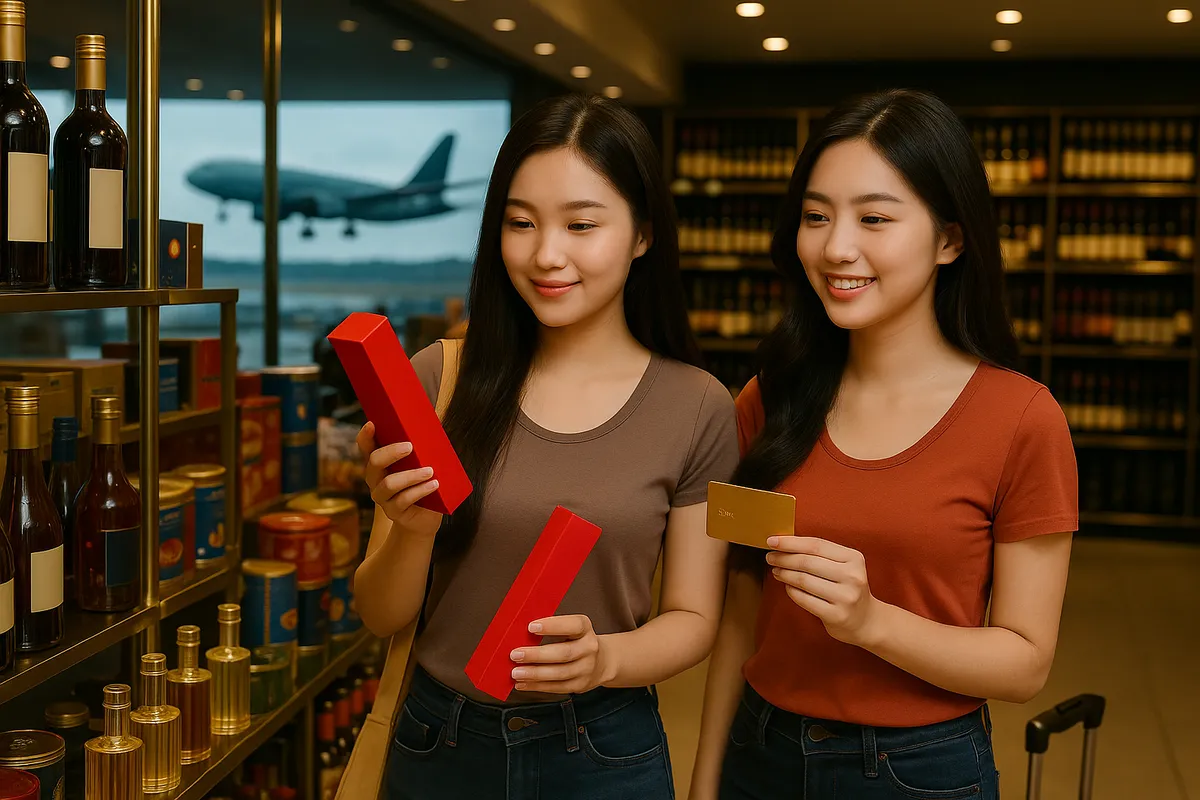Mẹo mua đồ Duty-Free ở sân bay có lời nhất ít người chia sẻ
- Thứ hai, 16/06/2025, 16:49 (GMT+7)
Mẹo mua đồ Duty-Free ở sân bay có lời nhất ít người chia sẻ
Mỗi khi chuyến bay quốc tế sắp cất cánh, không ít hành khách vội vàng ghé qua khu mua sắm Duty-Free với mong muốn mang về món hàng chất lượng giá rẻ. Nhưng giữa mê cung hàng hóa sáng loáng ấy, không phải ai cũng thực sự biết cách tận dụng lợi thế miễn thuế sao cho có lời, thậm chí rất nhiều người đang trả tiền nhiều hơn mà không hề hay biết. Việc mua sắm ở Duty-Free có lời hay không phụ thuộc vào nhiều yếu tố hơn là chỉ nhìn thấy chữ “Sale” hoặc “Tax Free”. Đó là cuộc chơi giữa hiểu biết và hành vi tiêu dùng, giữa cảm xúc bị kích thích và những mẹo ít ai chia sẻ.
Trước tiên, cần hiểu đúng bản chất của Duty-Free. Miễn thuế không đồng nghĩa với giá rẻ tuyệt đối. Hàng hóa ở đây không bị tính các loại thuế như VAT, thuế tiêu thụ đặc biệt hay thuế nhập khẩu tùy theo quy định mỗi nước. Tuy nhiên, mức giá cuối cùng còn bị ảnh hưởng bởi tỷ giá quy đổi, chi phí thuê mặt bằng cao ở sân bay, phí vận hành và cả chiến lược định giá của thương hiệu. Có những sản phẩm vẫn rẻ hơn giá thị trường nội địa, nhưng cũng có không ít món hàng lại đắt hơn cả khi mua tại các kênh phân phối truyền thống hoặc trực tuyến.
Một trong những mẹo đầu tiên để mua sắm thông minh ở Duty-Free chính là biết rõ giá gốc. Trước khi ra sân bay, nên kiểm tra giá món hàng dự định mua ở các nguồn tin cậy, bao gồm giá bán tại thị trường nội địa và quốc tế. Ví dụ một chai nước hoa phổ biến, khi tra giá tại Mỹ có thể là 85 đô la nhưng ở quầy Duty-Free tại sân bay châu Á lại niêm yết hơn 100 đô. Cảm giác đang tiết kiệm tiền vì “không tính thuế” thực ra lại là một cú lừa êm ái nếu không kiểm chứng trước đó.
Kinh nghiệm từ nhiều du khách từng đi qua hàng chục sân bay quốc tế cho thấy, các món hàng có khả năng “có lời” cao nhất ở Duty-Free thường rơi vào nhóm mỹ phẩm cao cấp, rượu vang hoặc rượu mạnh, socola ngoại nhập và một số dòng nước hoa đặc biệt chỉ phân phối tại sân bay. Đây là những mặt hàng có mức thuế nội địa khá cao hoặc bị làm giá tại thị trường trong nước, nên khi miễn thuế thực sự mang lại sự khác biệt rõ rệt. Đặc biệt, các combo mỹ phẩm mini size hoặc bộ sản phẩm độc quyền tại sân bay có giá trị sử dụng cao và thường khó tìm ở kênh bán lẻ bên ngoài.
Nhưng mua hàng Duty-Free không chỉ là chuyện chọn mặt hàng đúng, mà còn là cuộc chơi của thời điểm. Giờ bay sáng sớm hoặc đêm khuya thường ít người lui tới khu mua sắm, lúc này nhân viên tư vấn sẽ có nhiều thời gian tương tác và một số quầy hàng còn áp dụng khuyến mãi riêng theo khung giờ để thúc đẩy doanh số. Ngoài ra, các chuyến bay cất cánh từ các sân bay quốc tế lớn như Singapore, Incheon, Doha, Dubai thường có khu Duty-Free quy mô lớn và chính sách ưu đãi hấp dẫn hơn hẳn so với các sân bay nhỏ hoặc ít lưu lượng khách.
Một mẹo ít ai để ý nhưng cực kỳ hiệu quả là tận dụng chương trình “Reserve and Collect”. Với một số hãng hàng không và sân bay, người mua có thể đặt hàng online từ trước, chọn ngày bay và sân bay, sau đó chỉ việc ghé lấy hàng khi tới nơi. Mức giá ở kênh đặt trước này nhiều khi thấp hơn cả khi mua trực tiếp tại quầy, lại tránh được rủi ro hết hàng hoặc bị cuốn theo cảm xúc khi đứng giữa hàng trăm món đồ hấp dẫn. Đặc biệt, có những sân bay còn cho phép đặt hàng cả chiều đi và chiều về, giúp người đi công tác hoặc du lịch có thể chủ động so sánh và quyết định.
Một lưu ý quan trọng nữa là giới hạn hành lý và quy định hải quan. Nhiều người vì thấy đồ rẻ nên mua quá tay, nhưng đến khi qua cửa hải quan lại gặp rắc rối do vượt giới hạn cho phép mang hàng miễn thuế. Mỗi quốc gia có quy định khác nhau về số lượng rượu, thuốc lá, nước hoa được phép mang theo. Nếu bị phát hiện vượt mức, không những phải nộp phạt mà còn có thể bị tịch thu hàng hóa. Vì vậy, trước khi mua, cần tìm hiểu rõ quy định của nước đến và chuẩn bị cách sắp xếp hành lý thông minh để không gây nghi ngờ khi kiểm tra.
Trong khi nhiều người chăm chăm vào quầy hàng hiệu, lại có những món hàng nhỏ mà lợi nhuận mang lại cực kỳ cao nếu biết cách mua. Đó là vitamin, thực phẩm chức năng hoặc bánh kẹo nội địa tại các sân bay châu Âu và Mỹ. Một số loại thực phẩm không bán rộng rãi ngoài thị trường mà chỉ có tại Duty-Free với chất lượng đảm bảo và mức giá rất cạnh tranh nếu so với mua lẻ tại các chuỗi siêu thị chuyên biệt.
Thói quen tiêu dùng thông minh cũng nên đi cùng chiến lược sử dụng ngoại tệ. Khi thanh toán, nếu được hỏi nên trả bằng tiền nội địa hay quy đổi sang tiền nước ngoài, hãy chọn tiền bản địa của sân bay đang mua sắm để tránh bị mất phí quy đổi cao. Ví dụ, nếu đang ở sân bay Nhật và có thẻ Visa quốc tế, nên để thanh toán bằng Yên thay vì chọn hiển thị số tiền chuyển đổi sang Việt Nam đồng vì tỷ giá thường do ngân hàng quốc tế áp và cao hơn mức thực tế.
Một yếu tố then chốt khác là biết cách khai thác các dịch vụ hoàn thuế. Dù hàng Duty-Free đã miễn thuế, nhưng ở nhiều quốc gia vẫn có những quầy hàng bên ngoài khu Duty-Free cho phép hoàn thuế sau khi xuất cảnh nếu mua hàng đúng quy trình. Việc tận dụng đồng thời cả mua sắm tại cửa hàng nội địa có hoàn thuế và chọn lọc một số mặt hàng tại khu Duty-Free sẽ giúp tối ưu hóa chi tiêu. Tại Đức, Pháp, Hàn Quốc hay Thái Lan, không ít du khách đã tiết kiệm được vài triệu đồng chỉ nhờ tính toán khéo léo giữa hai hình thức này.
Quan sát hành vi mua sắm của nhiều du khách, dễ thấy nhóm người hay có quyết định sai lầm là những ai không lên kế hoạch trước, đi theo cảm xúc hoặc bị ảnh hưởng bởi thương hiệu và lời mời chào. Trong khi nhóm có khả năng mua được hàng tốt thường là người đã tìm hiểu kỹ, có danh sách sẵn và không bị cuốn vào bối cảnh xung quanh. Đặc biệt, những du khách từng đi nhiều lần thường chọn điểm mua tại chặng bay về vì hành lý đã nhẹ hơn, tâm lý không vội vã và dễ kiểm soát hơn so với lúc bắt đầu hành trình.
Điều cuối cùng, đừng quá tin vào “Giá giảm sốc” hay những biển giảm 40 đến 60 phần trăm bày đầy trước các quầy hàng. Hãy xem kỹ giá ban đầu, so sánh với giá thực tế tại thị trường trước đó, kiểm tra dung tích và thông tin đi kèm. Một lọ kem dưỡng có thể trông như khuyến mãi nhưng lại là size nhỏ hơn tiêu chuẩn, hoặc sản phẩm đã đổi bao bì mới bên ngoài với chi phí thấp hơn.
Mua hàng Duty-Free thực sự có lời chỉ khi người mua giữ được cái đầu lạnh, nắm rõ quy tắc và linh hoạt trong chiến lược. Đó không chỉ là nơi để tiêu tiền cuối cùng trước chuyến bay, mà là bài kiểm tra nhỏ về cách mỗi người kiểm soát túi tiền của mình giữa mê cung tiêu dùng hiện đại. Với những mẹo đã chia sẻ, mỗi hành khách hoàn toàn có thể bước vào khu mua sắm sân bay với tâm thế chủ động, biết mình cần gì, muốn gì và sẵn sàng gật đầu trước những món hời thực sự thay vì tiếc nuối sau khi máy bay đã rời khỏi đường băng.

 CHECKIN.VN
CHECKIN.VN








Chia sẻ trên